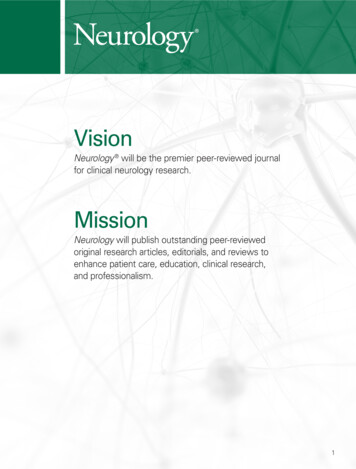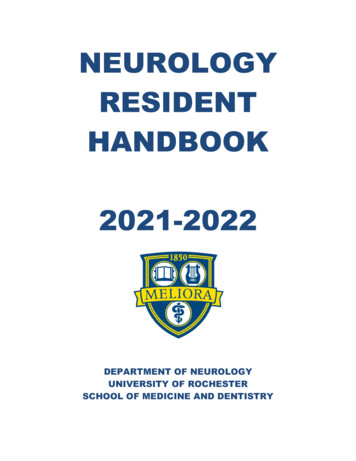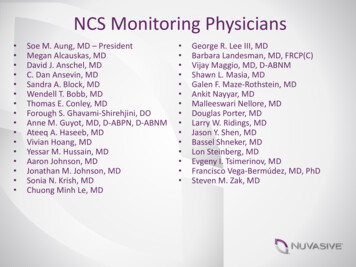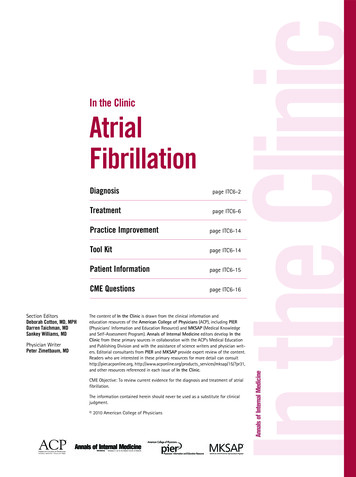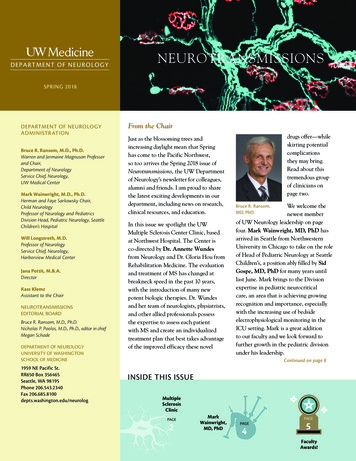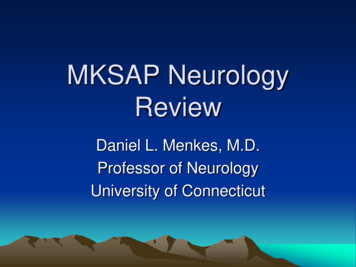
Transcription
MKSAP NeurologyReviewDaniel L. Menkes, M.D.Professor of NeurologyUniversity of Connecticut
Approach to neurology LOCALIZE the LESION!– “What means where” ELIMINATE EMERGENCIES FIRST!– VET those emergencies Vascular Electrical Traumatic Short differential diagnosis Treat the underlying pathology
2 overriding concepts Ockham’s Razor for lesions– Put the lesion in one site if possible OR– Localize to a particular tissue such as: Gray matter White matter Muscle “WIRE CROSSING IS BAD”– Tracts are PROPERLY laminated– KNOW where the tracts cross
4 Tracts for lesion localization MOTOR system [most important for localization]– Corticospinal Cortical Subcortical– Anterior horn cell starts the peripheral nervoussystem 2 sensory systems– DORSAL columns– Spinothalamic Cerebellar [least important for localization]
Motor system first![Strength, tone, atrophy, reflex] CNS lesion?– Hyper-reflexia (after initial shock)– Increased tone– NO ATROPHY (caveat: anterior horn cells) Peripheral lesion?– Decreased reflexes– Decreased tone– Atrophy (caveat: demyelinating neuropathies)
Reflex levels-count to 8REFLEXAnkleROOT LEVELS[1st of pair is predominant]S1 – S2KneeL3 – L4Biceps brachiiC5 – C6BrachioradialisC5 – C6Triceps brachiiC7 – C8
Central nervous system Cortical?––––Aphasia?Visual field cut?Abulia? Apraxia?Contralateral neglect? Subcortical?– Hemiparesis Brainstem– Cranial nerve lesion IPSILATERAL– Hemiparesis CONTRALATERAL Spinal cord?– Both sides of body usually affected– SENSORY LEVEL LOCALIZES TO SPINAL CORD
Peripheral nervous system Anterior horn cell/motor nerve roots– Invariant weakness with atrophy– NO SENSORY LOSS Peripheral nerve– Distal weakness WITH sensory loss NMJ– Waxing/Waning weakness– NO SENSORY LOSS Muscle– Invariant proximal distal weakness– NO SENSORY LOSS
SENSORY SYSTEM (2 types) LARGE FIBER/DORSAL COLUMN– Vibration/Position sensation– Afferent portion of reflex arc– HIGH CROSS SMALL FIBER/SPINOTHALAMIC– Light touch/Pin/Temperature sensation– LOW CROSS
Sensory tracts just below thecervicomedullary junction Dorsal columns: [CROSS at C1]– Sacral fibers are most MEDIAL– Cervical fibers are most LATERAL Spinothalamic: [IMMEDIATE CROSS]– Sacral fibers most LATERAL– Cervical fibers most MEDIAL
2nd Step: Sensory system If peripheral: NO DISSOCIATION– Sensory modalities lost together– No “splitting” If central: DISSOCIATION or LEVEL– Sensory level SPINAL CORD– Dissociation Pain and temperature affected on one side Vibration and position affected on the other
Cerebellum ABOVE cervicomedullary junction– Usually contralateral to affected side BELOW cervicomedullary junction– Tracts cross twice– Lesion is ipsilateral to affected side
Major Neurology Topics Headaches/Brain TumorsDelirium/Dementia/Stupor and ComaDizziness/Vertigo/Syncope/Hearing LossMovement disordersMS/Spinal cord diseasesNeuromuscular diseaseEpilepsyStroke
Headaches RED FLAGS:– “Worst headache of life”– Headache with ANY neurological deficits– Headache with papilledema– Headache with fever– Headache with jaw claudication ALL other headaches are usually migraine– Cluster headaches are extremely rare– Tension headaches are rarer still
Headaches Any “RED FLAG” headache requires:– Head CT WITHOUT contrast (exclude bleed)– LP if CT is negative– ESR if temporal arteritis is suspected Non red-flag headaches– Migraine– Cluster– Chronic parxoysmal hemicrania
Migraine headaches Unilateral pulsatile HA with photophonophobiaPathophysiology-Low pontine serotoninFemales MalesProphylaxis– Tricyclic antidepressants– Beta-blockers– Anticonvulsants (Depakote, Topamax) Abortive Triptans Sedatives Ergotamines
Cluster headaches Similar pathophysiology Males females Other differences– Wakes people from sleep in early AM– Relieved by 10-12 liters of oxygen by mask– Extreme agitation (migraineurs are reclusive)– Rhinorrhea and lacrimation
Brain Tumors Infiltrators– Primary CNS neoplasms– Neural crest derived tumors [melanoma] Displacers– Originate elsewhere– Supporting elements Meningioma Ependymoma
Tumor ComparisonInfiltratorsDisplacersSize mal deficitsSeizures/HAObvious deficitLocationDiffuseGray-Whitejunction
Delirium, Dementia, Stupor, Coma RED FLAGS:– Acute onset– Focal neurological deficits– Metabolic derangements DISEASES you should NEVER MISS:– Wernicke’s (always give Thiamine)– B12 or Folate deficiency– Thyroid disease induced encephalopathy
Delirium, Dementia, Stupor, oudedComaObtundedInteraction withenvironmentHostile butpurposefulNormal on thesurfaceMinimal butpurposefulReflex actionsonly
ApproachFocal neurological deficit? Yes: The brain is likely at fault– Head CT WITHOUT CONTRAST-STAT– LP if head CT is negative– EEG if LP is negative No: The brain is secondarily affected– This is a TOXIC-METABOLIC process– Medication/drug abuse history– CBC, CMP, TSH, B12, Folate– RPR, HIV with high index of suspicion
Dementia Do not diagnose until you have excluded:– Pseudodementia (e.g. depression)– Treatable dementias (B12, Folate, TSH) Otherwise, it is probably Alzheimer’s– Procholinergics slow the rate of decline– They do NOT reverse the disease process
Delirium 99.9% is toxic-metabolic in origin Exception: Non-dominant hemispherelesions– Acute stroke– Herpes simplex encephalitis Treatments– Find the underlying cause and address it– Tincture of time
Stupor and Coma FOCAL DEFICIT Brain is at fault LOCALIZE the lesion– Examine ALL cranial nerve reflexes: PupillaryBlinkOculocephalic [NOT Doll’s eyes]Pharyngeal [NOT gag]– Posturing? Decorticate or arm flexion above red nucleus Decerebrate or arm extension below red nucleus
Dizziness, Vertigo, Hearing Loss Define vertigo– Illusion of motion– “Spinning” is not necessary Occurs from mismatch of sensory inputs– Vision– Posterior columns– Vestibular system MUST differentiate “central “ from“peripheral”
Central versus peripheralCentralPeripheralLong tract signs PresenceNEVERconfirms centralHearing lossEXTREMELYRAREVirtuallydiagnosticFatiguesNoYes
Common causes of vertigo Benign Positional– Provoked in 1 position ONLY– Fatigues with each provoking maneuver Meniere’s disease is TRIAD of– Hearing loss [Localizes to periphery]– Tinnitus– Vertigo Stroke– Long tract signs– Cerebellar deficits
Movement disorders BALANCE of Ach and DA– Increased Ach Decreased DA– Increased DA Decreased Ach Excess DA leads to:– Psychosis– Chorea Reduced DA leads to– Parkinsonism– Dystonia/Rigidity
Movement disorders Parkinson’s Disease [Idiopathic]– Too little DA in Substantia Nigra– FOUR cardinal features TremorRigidityBradykinesiaPostural instability– Should respond to DA agonists Parkinson’s Plus syndromes do NOT respond toDA therapy
Tremors Essential– Action tremor– Disappears at rest Parkinson’s tremor– Tremor at REST– Disappears wit movement Cerebellar Tremor [RARE]– Worsens as the target is approached– Clinically obvious
Movement disorder therapy “Move too much give them sedatives”– Beta-blockers– Barbiturates– Benzodiazepines “Move too little try some Sinemet”– Use DA agonists below age 60– Start Sinemet at age 60 or greater
Some exceptions Acute dystonic reaction from DA blocker– Block Ach to restore balance– Use diphenhydramine IV Parkinson’s tremor does NOT respond toDA therapy– Non-anticholinergic sedatives required Focal dystonia responds best to Botulinumtoxin injectins
Multiple Sclerosis A WHITE MATTER CNS disease Two distinct clinical episodes separated inSPACE and TIME– Space: Must affect DIFFERENT white matterlocations– Attacks must be more than 30 days apart MRI criteria can be used instead of anactual SECOND clinical attack
1 lesion Multiple Sclerosis Diagnosis based on location– Optic tract Optic Neuritis– Spinal cord Transverse myelitis– Cerebellum Acute cerebellitis Risk of MS increased after first attack IV steroids hasten recovery but have NOEFFECT on probability of second attack IV steroids are superior to oral steroidswhich are placebo
MS therapy Acute attack- IV methylprednisolone– Given as 500 mg IV bid for 3-5 days Reduce relapse frequency/progression– Interferons– Copaxone When above agents fail:– Cyclophosphamide– Mitoxantrone
Spinal cord disorders ALWAYS eliminate cord compression:– Plain X-rays to exclude bony pathology– MRI CSF exam if previous studies are normal:– Transverse myelitis– Meningomyelitides Other odd causes– Spinal cord strokes– B12 deficiency
Neuromuscular LOCALIZE the lesion– Motor, Sensory or both?– Trunk, shoulder or hip girdle involved?– Face involved? If motor affected:– Constant or variable weakness?– Atrophy?– Tone increased or decreased?
Nerve structure Myelin sheath– For rapid conduction of impulses– Vibration and position sense– Motor function Vasa nervorem– Blood vessels end on nerve surface– Loss of perfusion affects small fibers in nerve center Axons– Most metabolically active– Atrophy when the motor axons are injured
Neuropathy vs. myopathy vs. NMJ Neuropathy vs. myopathies– Most neuropathies cause distal beforeproximal dysfunction– Muscle diseases affect proximal before distal NMJ disorders usually involve the CNs– NO sensory loss– NO atrophy– Extraocular muscles affected early
Myelinopathy versus axonopathy Reflexes lost early Large fiber sensoryloss Weakness withminimal atrophy CSF protein may beincreased Patterns other thandistal to proximal Reflexes retaineduntil late Small large fibersensory loss CSF protein normal Distal to proximaldysfunction
Myopathies Inflammatory usually have increased CPK– Polymyositis: Cellular infiltrate– Dermatomyositis: A vasculitis Non-inflammatory have normal tominimally elevated CPK Diagnosis can only be established bybiopsy
Epilepsy A disorder of the cortical gray matter Definition:– 2 UNPROVOKED seizures– A CLINICAL diagnosis Provoked seizure examples:– Syncope– Sleep deprivation– Alcohol withdrawal
Epilepsy diagnosis Clinical to classify the epilepsy– Reliable witness– Tongue laceration– Prolonged LOC EEGs do NOT diagnose epilepsy– Many patients have normal EEGs– Spikes on an EEG do NOT prove epilepsy
Evaluation Elicit complete history to exclude a provokedseizure CBC, CMP, UDS at a minimum Imaging– Generalized only requires head CT– Focal onset REQUIRES MRI EEG– Highest positives within 24 hrs– Anticonvulsants do NOT suppress abnormalities
Treatment Treatment of a first unprovoked seizure iscontroversial but most will do so if any ofthe following are noted:– Focal onset– EEG abnormalities noted– MRI abnormality in cortical gray noted All anticonvulsants have the same efficacyfor most seizure types-they differ in sideeffects
Treatment exceptions Juvenile myoclonic epilepsy– Valproic acid– Lamotrigine Absence seizures– Valproic acid– Ethosuximide
MKSAP Neurology Review Daniel L. Menkes, M.D. Professor of Neurology . University of Connecticut . Approach to neurology LOCALIZE the LESION! – “What means where” ELIMINATE EMERGENCIES FIRST! – VET those emergencies Vascular Electrical TraumaticFile Size: 1MB



